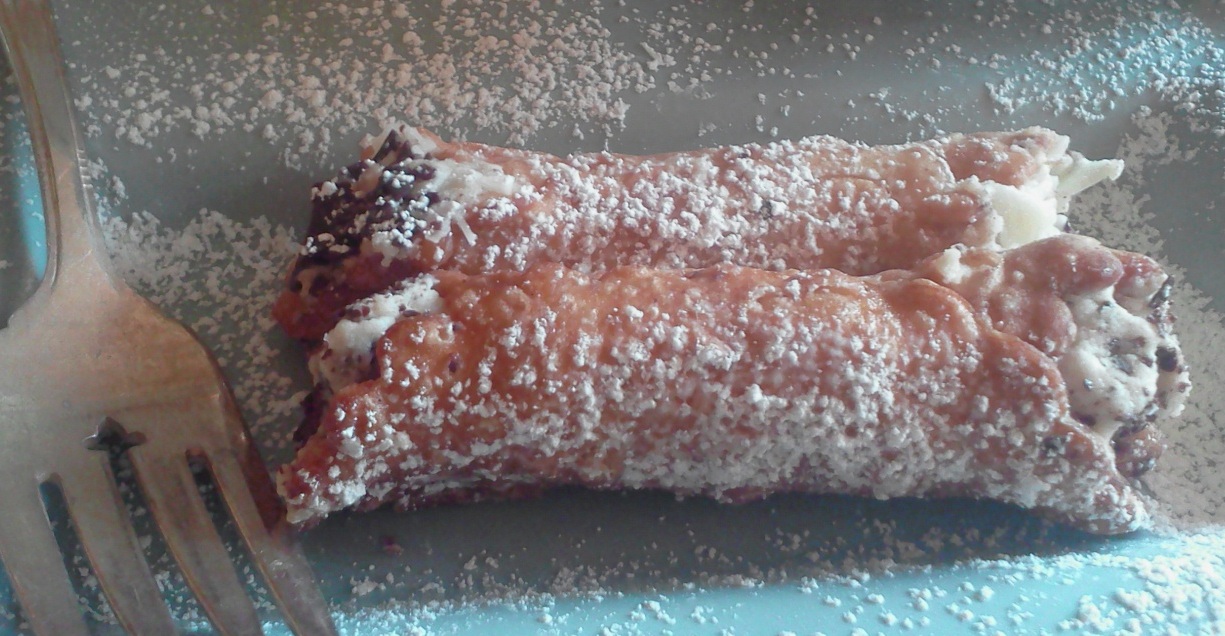I fell in love with cannoli in Turin, Italy, at the Terra Madre conference a few months ago. The cannoli I bought were fat but small – like half a pencil long – crunchy on the outside, creamy in the middle, dipped in chopped chocolate.
If you’ve never had the pleasure of meeting and eating cannoli, they are slightly sweet, with a flaky, deep-fried cylinder-shaped dough that’s filled with a ricotta-cheese mixture, but my recipe features a filling made with whipped cream, too.
Son Joe and daughter-in-law Marie shared my love of cannoli at the Slow Food conference. Not that we overdid it. Well, maybe one or two little cannoli every other day or more.
The three-syllable cannoli are not to be confused with the four-syllable cannelloni, those savory tube-shaped pastas about the size of a slimmed down burrito. Typically, cannelloni contain a ricotta cheese mixture and ingredients like spinach and meats, topped with either a white sauce or marinara. And while we’re clearing up Italian food rhetoric, cannelloni are not to be confused with manicotti, which are small pasta sheets rolled into tubes, then filled.
But today we’re talking about cannoli – which, btw, is the plural of cannolo, a word I need not ever utter since I can never just eat one.
Hence, when I returned home from Italy with a craving for cannoli, I vowed to make my own.
How hard could it be?
Well, just a little bit.
Three things tripped me up with making cannoli. First, there’s the matter of the required cannoli tubes. I already had a dozen little metal cannoli cylinders I bought a few years back, just waiting for the day when I worked up enough courage to attempt cannoli.
You can see a cannolo tube at the bottom of the photo, below the cream horn form. See how small the cannoli tube is? It wasn’t until later that I learned that cannoli tubes come in different sizes. Apparently, my tubes were the mini size, but I wouldn’t know that at my first attempt. 
Not to get too off topic here, but there’s an employee named Dan at Orchard Supply who will no doubt run the other direction the next time he sees me because he had the misfortune of waiting on me the day I was convinced that the plumbing department held the secret to my getting larger diameter tubes. I bought two feet of aluminum tubing and then asked him to cut it into 12 pieces. He got to about 7 when he quit, sweating, saying that was enough. OK, fine.
My second challenge was the dough itself, which was unlike any dough I’ve ever made. For one thing, I’ve never encountered a dough recipe that required 1/2 cup of booze, so that surprised me. Also, I expected the dough to be soft, like bread dough, or fragile, like cookie dough. The cannoli dough was pretty stiff and substantial, more like pasta dough. In fact, I followed the advice that I found mentioned in a few recipes, and used my pasta machine to roll out the cannoli dough as thinly as possible. I am so glad I did. I cannot imagine what a pain it would have been to roll out the dough that thinly by hand.
Finally, the third challenge I faced with the cannoli was the deep-frying part. I am not a fan of deep-frying. Not that I don’t love the results (hello French crullers), but because frying makes the house smell like grease. And it’s kind of messy.
Wait, I forgot. There was one more issue: filling the cannoli. After I deep-fried the mini cannoli, the available opening into which to pipe the filling was about as big in diameter as the tip of my index finger. It was like trying to fill a fat straw with a pastry bag. Not easy.
Speaking of fillings, many cannoli fillings contain a heavy concentration of ricotta cheese, and they sometimes include citron. I prefer a balance of whipped cream and ricotta, and no citron, but I compromise with grated orange rind.
Despite the cannoli being tricky to fill, once they were filled, and once I dipped the exposed filled ends in chocolate, the result was just as I’d hoped and dreamed.
Delicioso!
Cannoli
Makes approximately 30 cannoli
Cannoli shells:
3 cups flour
1/4 cup sugar
1/4 teaspoon cinnamon
3 tablespoons shortening
1 egg
1 egg yolk
1/2 cup sweet Marsala wine (or white rum, or, for a non-alcoholic version, apple cider)
3 tablespoons water
1 egg white
1 quart oil for frying, or as needed
Filling:
1 lb. container ricotta cheese
1 cup heavy whipping cream, whipped
1/2 cup powdered sugar
1 tsp. grated orange rind
4 ounces semisweet chocolate, chopped (optional)
Mix the flour, sugar and cinnamon into a large bowl. Add the shortening to the dry mixture and blend, using either your finger tips or pastry blender until it’s in pea-sized pieces.
Use a large spoon to make a well in the center of the ingredients. Into the well pour the egg, egg yolk, Marsala wine, vinegar and water.
Use a fork to blend everything until the fork will no longer work. Then use your hands to knead the dough by hand on a lightly floured, clean surface. (If the dough is too dry, add a little more water.) Knead for about 10 minutes, or until smooth. Cover and refrigerate for a few hours.
Divide the cannoli dough into four pieces. If using a pasta machine, flatten each dough disk enough to feed it through a pasta machine opening. Roll the dough through successively thinner settings until you have reached the thinnest setting (6 or 7 on the dial).
If the dough is damp, dust it lightly with flour. Place one sheet of the cannoli dough on a lightly floured surface. Cut a circle using a 4-to-5 inch circular cookie or biscuit cutter, cut as many circles from that sheet as possible. Collect dough scraps and reroll and cut until all that sheet is gone. Repeat with the remaining dough, dusting with flour as you start collecting the circles to prepare for wrapping around the tubes.
Carefully roll dough around cannoli tubes, and use egg white to seal the edges.
In a deep, heavy pan, heat the oil to 375 degrees. Place a few of the dough-covered tubes at a time in the hot oil for about 2 minutes, until they are golden brown. Use long-handled tongs to turn as they fry so they cook evening.
Using the tongs, carefully remove the tubes and let cool just long enough to gently remove the crisp dough cylinders. Reuse the tubes as they cool with the other dough discs.
Fried, cooled cannoli tubes may be kept in an airtight container for a few weeks until you are ready to fill them. Once filled, the cannolis are best when eaten immediately.
Filling: Stir together the ricotta cheese and confectioners’ sugar using a spoon. Fold in the grated onange and the whipped cream. Fill a pastry bag with the cheese and whipped cream mixture and pipe the mixture into the tubes. (It’s easiest to fill one side, and then the other, rather than trying to fill the entire cannoli from one end with one squirt. Dust the filled tubes with confectioners’ sugar and dip each end into grated chocolate or mini chips before serving. Keep chilled, but serve as soon as possible.
 Independent online journalist Doni Chamberlain founded what’s now known as anewscafe.com in 2007 with her son, Joe Domke of the Czech Republic. Prior to 2007 Chamberlain was an award-winning newspaper opinion columnist, feature and food writer recognized by the Associated Press, the California Newspaper Publishers Association and E.W. Scripps. She lives in Redding, CA.
Independent online journalist Doni Chamberlain founded what’s now known as anewscafe.com in 2007 with her son, Joe Domke of the Czech Republic. Prior to 2007 Chamberlain was an award-winning newspaper opinion columnist, feature and food writer recognized by the Associated Press, the California Newspaper Publishers Association and E.W. Scripps. She lives in Redding, CA.



